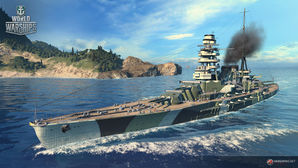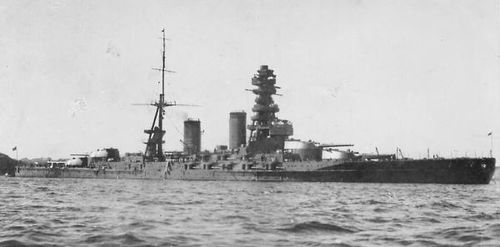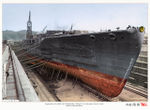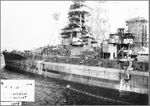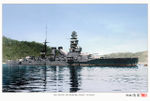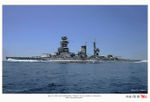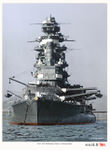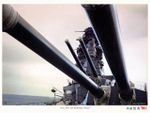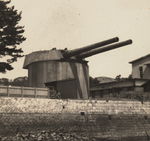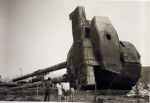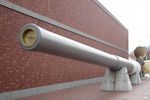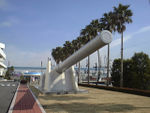Mutsu
| Revision as of 16:17, 1 February 2017 | Revision as of 03:43, 2 February 2017 General edits and clean-up to Historical Design and Service sections. | |||
| Line 71: | Line 71: | |||
| |Signals=<!-- write text about best set of signals below --> | |Signals=<!-- write text about best set of signals below --> | |||
| + | ||||
| + | {{Signal Flags | |||
| + | | Hotel Yankee = | |||
| + | | Juliet Charlie = | |||
| + | | November Foxtrot = | |||
| + | | Zulu = | |||
| + | | Juliet Yankee Bissotwo = | |||
| + | | India Delta = | |||
| + | ||||
| + | | India Yankee = | |||
| + | | November Echo Setteseven = | |||
| + | | Zulu Hotel = | |||
| + | | India Bravo Terrathree = | |||
| + | | Sierra Mike = | |||
| + | | Victor Lima = | |||
| + | ||||
| + | | Mike Yankee Soxisix = | |||
| + | | Papa Papa = | |||
| + | | India X-Ray = | |||
| + | | Equal Speed Charlie London = | |||
| + | | Juliet Whiskey Unaone = | |||
| + | | Dragon Flag = | |||
| + | }} | |||
| |Gallery=<!-- write below list of files with description (if necessary) separated with | --><gallery> | |Gallery=<!-- write below list of files with description (if necessary) separated with | --><gallery> | |||
| ? | File:MutsuFires.jpg|''Mutsu'' opens up with her 16 inch battery. | + | File:MutsuFires.jpg|''Mutsu'' opens up with her 16-inch battery. | |
| File:MutsuBroadside.jpg|''Mutsu'' fires a full broadside. | File:MutsuBroadside.jpg|''Mutsu'' fires a full broadside. | |||
| File:MutsuCVDB.jpg|[[ship:Independence|''Independence'']] dive bombers score hits. | File:MutsuCVDB.jpg|[[ship:Independence|''Independence'']] dive bombers score hits. | |||
| Line 85: | Line 108: | |||
| {{AnnoWiki|content= | {{AnnoWiki|content= | |||
| <h3>Construction</h3> | <h3>Construction</h3> | |||
| ? | :Yokosuka Naval Yard; Yokosuka, Japan | + | :Yokosuka Naval Yard; Yokosuka, Japan | |
| ? | :Laid down: 1 June 1918 | + | :Laid down: 1 June 1918 | |
| ? | :Launched: 31 May 1920 | + | :Launched: 31 May 1920 | |
| :Commissioned: 22 November 1921 | :Commissioned: 22 November 1921 | |||
| ---- | ---- | |||
| ====Specifications==== | ====Specifications==== | |||
| ? | :32,700 tons displacement, standard | + | :32,700 tons displacement, standard | |
| ? | :215.8m length | + | :215.8m length | |
| ? | :28.96m beam | + | :28.96m beam | |
| :9.08m draft | :9.08m draft | |||
| ---- | ---- | |||
| ====Machinery==== | ====Machinery==== | |||
| ? | : | + | :21 boilers, 4 turbines | |
| ---- | ---- | |||
| ====Performance==== | ====Performance==== | |||
| ? | :26.7 knots at 80,000 shaft horsepower | + | :26.7 knots at 80,000 shaft horsepower | |
| :5,500 nautical miles at 16 knots | :5,500 nautical miles at 16 knots | |||
| ---- | ---- | |||
| ====Armor==== | ====Armor==== | |||
| ? | :Main belt: 102-305mm | + | :Main belt: 102-305mm | |
| ? | :Decks: 38-76mm main | + | :Decks: 38-76mm main | |
| ? | :Barbettes and Turrets: 305mm barbette, 305mm turrets | + | :Barbettes and Turrets: 305mm barbette, 305mm turrets | |
| ? | :Casemates: 25mm | + | :Casemates: 25mm | |
| :Conning tower: 368mm | :Conning tower: 368mm | |||
| ---- | ---- | |||
| Line 127: | Line 150: | |||
| ====Design==== | ====Design==== | |||
| ? | The ''Nagato | + | The ''[[Nagato]]''-class battleships were the last pair of battleships build by the Japanese Navy before the global hiatus on capital ship construction due to the ratification of the Washington and London Naval Treaties. As such, the ''Nagato''-class is seen as the culmination of all the experience learned by the Japanese Navy in dreadnought design and construction up through the end of World War I. | |
| ? | + | Led by famed naval architect Yuzuru Hiraga, construction of the ''Nagato''-class began in 1916. By this time, Japan was a steadfast, growing naval power and wanted their designs to reflect such a status. As such, from the outset the ''Nagato''-class were set to be first-rate dreadnoughts, competitive with the offerings of the other navies of the world (chiefly the ''[[Colorado]]''-class battleships that were being built by the United States). Hiraga and his team were meticulous, delaying final completion of her plans until mid-1917 in order to incorporate the lessons learned from the Battle of Jutland the previous year. What ultimately emerged were the most advanced battleships afloat in the world. | ||
| ? | The Japanese determined that high-speed was an integral asset | + | The Japanese determined that high-speed was an integral asset to making a battleship an effective weapon; as such, the ''Nagato''-class were designed to be the fastest battleships in the world. It was decided to fit no less than twenty-one (21) Kampon boilers into them: fifteen (15) oil-fired and six (6) mix-fired. These boilers then fed into four (4) geared turbines that each powered a single screw. Altogether, they generated 80,000 shaft horsepower and propelled the ships to speeds above 26 knots, significantly faster than their competition. This was not a fact the Japanese Navy boasted about, however, instead electing to keep the true speed a closely guarded secret. In fact, the US Navy didn’t know the true speed of the class until well into the late 1930s. | |
| ? | In electing to focus on | + | In electing to focus on propulsion and speed, weight had to be saved from the armoring. Ergo, the Japanese opted to implement the “all-or-nothing” armor principle that was championed by the US; maximal armor to the vital areas whist non-critical surfaces receives minimal armor. The main belt and the barbette rings received 12 inches of armor, whilst the conning tower and the turret faces received 14 inches and 18 inches of armor, respectively. While this was sufficient to rival other battleships of the period, British and US battleships all had heavier armor, with belt armors exceeding 13 inches for many classes. | |
| ? | After experimentation with | + | After experimentation with the six turret design of the ''[[Fuso]]'' class, Hiraga and his designers decided to revert back to a quadruple turret design, determining this configuration to be the most effective. In order to not decrease overall firepower — by reducing the number of barrels from 12 to 8 — the caliber each rifle was increased from the traditional 14 inches to 16 inches; in fact, the ''Nagato''-class battleships were the first ships in the world to mount 16-inch naval rifles. To supplement the primary artillery, twenty (20) 5.5-inch casemate guns were added to the hull. Interestingly, the ''Nagato''-class retained the Japanese tradition of fitting torpedo tubes to their battleships. Historically, eight (8) total tubes were incorporated in the design; 4 above the waterline and 4 submerged (only the four above the waterline are available in-game). | |
| ? | ''Mutsu'' | + | ''Mutsu'' was the second of the two ''Nagato''-class battleships, built at the Naval Arsenal in Yokosuka. She was laid down 1 June 1918, launched 31 May 1920, and completed 24 October 1921. | |
| ? | The ''Nagato | + | The ''Nagato''-class underwent a modernization in the late 1920s and a reconstruction in the 1930s to keep the designs combat-capable. During the 1920s modernization, the first funnel was replaced with a serpentine funnel with a raked-top in order to attempt to fix the issue of the superstructure being occluded with smoke; the very funnel seen in-game. Furthermore, the torpedo tubes were traded-in for anti-aircraft artillery, in order to counter the growing threat of aircraft. Unique to ''Mutsu'', her bow was remodeled in order to decrease water spray to her foredeck. The 1930s reconstruction proved to be a more extensive overhaul. The iconic 7-masted superstructure was replaced with a pagoda-mast style design, and the first funnel was removed altogether. The old boilers were replaced; the overall number was also reduced to just ten (10). Furthermore, torpedo bulges were introduced. To mitigate the loss in ship speed due to the added weight, the length of the battleships were increased. Finally, a catapult was added to launch scout planes off the deck. | |
| ====Service==== | ====Service==== | |||
| + | Commissioned in October 1921, ''Mutsu'' survived the Washington Naval Treaty, was assigned to BatDiv (Battleship Division) 1, and began an uneventful interwar career. From 1927 to 1933, ''Mutsu'' would receive periodic modifications, but in September 1934 she was entirely rebuilt and modernized, and she remained in port until September 1936. | |||
| ? | + | With the beginning of war with China in July 1937, ''Mutsu'', having returned to BatDiv 1 alongside ''Nagato'', joined the fleet for security and blockade patrols off the China coast. ''Mutsu'' would continue operations off China until March 1941. In August 1941, ''Mutsu'' began preparations as Japan planned for hostilities with the United States. | ||
| ? | + | |||
| ? | With the beginning of war with China in July | + | ||
| ? | ''Mutsu'' would spend the beginning of World War II, from December | + | ''Mutsu'' would spend the beginning of World War II, from December 1941 to May 1942, in reserve and training. In June, she and the rest of BatDiv 1, now with ''[[Yamato]]'', sortied as part of the Main Body for Operation MO, the invasion of Midway. Other than to receive the transfer of survivors from ''Akagi'', ''Kaga'', ''[[Hiryu]]'', and ''Soryu'', ''Mutsu'' would not participate in the battle, and returned to Japan. | |
| ? | In July, BatDiv 1, less ''Yamato'', was attached to the 2nd Fleet. In August, they depart for Truk after the US landing at Guadalcanal. In late August, Mutsu was assigned to support the Main Body for the Battle of the Eastern Solomons, where she fired at an aircraft shadowing the fleet. This would prove to be her only shots fired in combat during the war. | + | In July, BatDiv 1, less ''Yamato'', was attached to the 2nd Fleet. In August, they depart for Truk after the US landing at Guadalcanal. In late August, ''Mutsu'' was assigned to support the Main Body for the Battle of the Eastern Solomons, where she fired at an aircraft shadowing the fleet. This would prove to be her only shots fired in combat during the war. | |
| ? | In September, ''Mutsu'' landed a party to help train anti-aircraft crews at Truk. She would remain and participate in exercises until January | + | In September, ''Mutsu'' landed a party to help train anti-aircraft crews at Truk. She would remain and participate in exercises until January 1943, when she returned to Japan. Excepting one aborted sortie to the Aleutians after the Battle of the Komandorski Islands in late March 1943, ''Mutsu'' continued to conduct training and gunnery exercises until June 1943. | |
| ? | On | + | On 8 June 1943, ''Mutsu'' was moored in Hashirajima harbor when, at approximately 1200 hours, her No. 3 turret suffered an explosion. The blast tore her in two, and the section forward the No. 3 turret rolled over and quickly sank. Her stern section sank early the next day. Of her 1,474 crew, 1,121 were killed. An investigation concluded human error was responsible for the explosion, and the Japanese Navy consequently altered regulations for the handling of explosives aboard ships. | |
| ? | ''Mutsu'' was | + | ''Mutsu'' was struck from the Navy List on 1 September 1943. | |
| ? | Post-war salvage attempts proved to be failures, though ''Mutsu | + | Post-war salvage attempts proved to be failures, though ''Mutsu''’s No. 4 turret, anchors, and other parts of the ship, as well as her bow, were recovered in the 1970s. The gun barrels from the salvaged No. 4 turret were restored and are now on display in separate locations in Japan: one at the [https://www.funenokagakukan.or.jp/ Museum of Maritime Science] in Tokyo, and the other outside the [https://www.yamato-museum.com/en/ Yamato Museum] in Kure. | |
| |HistoricalGallery=<!-- write below list of files with description (if necessary) separated with | --><gallery> | |HistoricalGallery=<!-- write below list of files with description (if necessary) separated with | --><gallery> | |||
| Line 172: | Line 194: | |||
| File:ONI-Nagato-class.jpg|US Office of Naval Intelligence recognition drawing of a ''[[Nagato]]''-class battleship. | File:ONI-Nagato-class.jpg|US Office of Naval Intelligence recognition drawing of a ''[[Nagato]]''-class battleship. | |||
| File:Mutsu09.jpg|''Mutsu''’s original No. 4 turret — removed during her reconstruction period in the mid-1930's — on display at the grounds of the former Imperial Japanese Naval Academy at Etajima, circa 1947. | File:Mutsu09.jpg|''Mutsu''’s original No. 4 turret — removed during her reconstruction period in the mid-1930's — on display at the grounds of the former Imperial Japanese Naval Academy at Etajima, circa 1947. | |||
| ? | File:Mutsu10.jpg|In the early 1970's, salvage operations were conducted that removed large portions of ''Mutsu''’s wreck from the ocean. This is turret No. | + | File:Mutsu10.jpg|In the early 1970's, salvage operations were conducted that removed large portions of ''Mutsu''’s wreck from the ocean. This is turret No. 4 following its removal from the wreck in 1971. | |
| File:Type 3 140mm Gun from Battleship Mutsu - 1-wp.jpg|A 140mm 3rd Year Type naval gun salvaged from ''Mutsu'' is on display at the [https://www.yasukuni.or.jp/english/yushukan/index.html Yasukuni Museum] in Tokyo, Japan. | File:Type 3 140mm Gun from Battleship Mutsu - 1-wp.jpg|A 140mm 3rd Year Type naval gun salvaged from ''Mutsu'' is on display at the [https://www.yasukuni.or.jp/english/yushukan/index.html Yasukuni Museum] in Tokyo, Japan. | |||
| File:Mutsu08.jpg|One of ''Mutsu''’s 410mm guns is on display outside the [https://www.yamato-museum.com/en/ Yamato Museum] in Kure, Japan. | File:Mutsu08.jpg|One of ''Mutsu''’s 410mm guns is on display outside the [https://www.yamato-museum.com/en/ Yamato Museum] in Kure, Japan. | |||
Revision as of 03:43, 2 February 2017
| 410 mm/45 3rd Year Type in a twin turret4 х 2 pcs. |
| Rate of Fire2 shots/min. |
| Reload Time30 sec. |
| Rotation Speed3.8 deg./sec. |
| 180 Degree Turn Time47.37 sec. |
| Firing Range20.35 km. |
| Maximum Dispersion230 m. |
| HE Shell410 mm HE Type0 |
| Maximum HE Shell Damage6,500 |
| Chance of Fire on Target Caused by HE Shell30 % |
| Initial HE Shell Velocity805 m./s. |
| HE Shell Weight938.5 kg. |
| AP Shell410 mm AP/APC Type88 |
| Maximum AP Shell Damage12,400 |
| Initial AP Shell Velocity790 m./s. |
| AP Shell Weight1000 kg. |
| 140 mm/50 3rd Year Type on a casemate mount20 х 1 pcs. |
| Firing Range4.96 km. |
| Rate of Fire7.5 shots/min. |
| Reload Time8 sec. |
| HE Shell140 mm HE Type0 |
| Maximum HE Shell Damage2,400 |
| Initial HE Shell Velocity850 m./s. |
| Chance of Fire on Target Caused by HE Shell10 % |
| 127 mm/40 Type 89 on a Model A1 mount4 х 2 pcs. |
| Firing Range4.96 km. |
| Rate of Fire12 shots/min. |
| Reload Time5 sec. |
| HE Shell127 mm HE Type0 |
| Maximum HE Shell Damage2,100 |
| Initial HE Shell Velocity725 m./s. |
| Chance of Fire on Target Caused by HE Shell8 % |
| 533 mm Single4 х 1 pcs. |
| Rate of Fire2.86 shots/min. |
| Reload Time21 sec. |
| Rotation Speed25 deg./sec. |
| 180 Degree Turn Time7.2 sec. |
| Torpedo533 mm Type6 |
| Maximum Damage10,833 |
| Torpedo Speed57 knot |
| Torpedo Range6.99 km. |
| 127 mm/40 Type 89 on a Model A1 mount4 х 2 pcs. |
| . . . Average Damage per Second40.4 |
| . . . Firing Range5.01 km. |
| 7.7 mm/80 Type 92 on a single mount3 х 1 pcs. |
| . . . Average Damage per Second4.8 |
| . . . Firing Range0.99 km. |
| 40 mm/62 "HI" Type 91 on a twin mount2 х 2 pcs. |
| . . . Average Damage per Second15.8 |
| . . . Firing Range2.01 km. |
| Maximum Speed26.5 knot |
| Turning Circle Radius750 m. |
| Rudder Shift Time13.7 sec. |
| Surface Detectability Range16.41 km. |
| Air Detectability Range10.63 km. |
Mutsu — Japanese special premium Tier VI battleship.
A Nagato-class battleship designed using experience gained in World War I to become one of the first "high-speed" battleships. The ship's armor protection was very good for her time. In addition to her primary armament, she also carried torpedo tubes.
Modules
 |
Rate of Fire (shots/min) | Torpedo Tubes Reload Time (sec) | 180° Turn Time (sec) | Maximum Damage (HP) | Torpedo Speed (knot) | Torpedo Range (km) |
Research price (exp) |
Purchase price ( | |
|---|---|---|---|---|---|---|---|---|---|
| Type 6 | 2.9 | 21 | 7.2 | 10,833 | 57 | 7 | 0 | 0 |
Compatible Upgrades
| Slot 1 |
|||||
|---|---|---|---|---|---|
| Slot 2 |
|||||
| Slot 3 |
|||||
| Slot 4 |
Player Opinion
Research
Optimal Configuration
Commander Skills
| Recommended Commander Skills | ||||||||
|---|---|---|---|---|---|---|---|---|
| Cost (points) |
Endurance | Attack | Support | Versatility | ||||
| 1 |
|
|
|
|
|
|
|
|
| 2 |
|
|
|
|
|
|
|
|
| 3 |
|
|
|
|
|
|
|
|
| 4 |
|
|
|
|
|
|
|
|
| Key: ★★★ - Extremely Useful ★★ - Frequently Useful ★ - Occasionally Useful No stars - Meh Χ - Not recommended | ||||||||
Camouflage
As a premium ship, Mutsu comes included with Type 10 camouflage that lowers her detection radius, reduces the accuracy of incoming shells, and increases the amount of experience she earns.
Signals
Recommended Signal Flags 
| |||||
|---|---|---|---|---|---|
| Combat | |||||

|

|

|

|

|

|

|

|

|

|

|

|

|

| ||||
Gallery
Independence dive bombers score hits.
Torpedo bombers from an enemy Independence class aircraft carrier drop their ordinance as the Mutsu fires at their home base.
Historical Info
Historical Gallery
| Destroyers | II Tachibana |
| Cruisers | I Hashidate • II Chikuma • III Tenryū • III Katori |
| Battleships | II Mikasa |
| Aircraft Carriers | IV [[Ship:Hōshō (< 23.01.2019)|Hōshō (< 23.01.2019)]] • IV Hōshō • V [[Ship:Zuihō (< 23.01.2019)|Zuihō (< 23.01.2019)]] • VI [[Ship:Ryūjō (< 23.01.2019)|Ryūjō (< 23.01.2019)]] • VI Ryūjō • VII [[Ship:Hiryū (< 23.01.2019)|Hiryū (< 23.01.2019)]] • VII [[Ship:Kaga (< 23.01.2019)|Kaga (< 23.01.2019)]] • VIII [[Ship:Shōkaku (< 23.01.2019)|Shōkaku (< 23.01.2019)]] • VIII Shōkaku • VIII Kaga |
